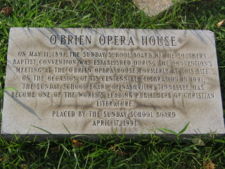O'Brien's Opera House: Difference between revisions
No edit summary |
No edit summary |
||
| Line 1: | Line 1: | ||
[[Image:ObrienOperaHouse.jpg|right|225px|thumb|Plaque commemorating the O'Brien Opera House on 1st Avenue and 19th Street North]] | [[Image:ObrienOperaHouse.jpg|right|225px|thumb|Plaque commemorating the O'Brien Opera House on 1st Avenue and 19th Street North]] | ||
The '''O'Brien Opera House''' (or '''O'Brien's Opera House''') was a "gas light" theater located at the northwest corner of [[1st Avenue North|1st Avenue]] and [[19th Street North]] in downtown [[Birmingham]]. The theater was constructed for traveling vaudeville shows by [[Frank P. O'Brien]], who would later be [[Jefferson County Sheriff|sheriff]] and [[Mayor of Birmingham|mayor | The '''O'Brien Opera House''' (or '''O'Brien's Opera House''') was a "gas light" theater located at the northwest corner of [[1st Avenue North|1st Avenue]] and [[19th Street North]] in downtown [[Birmingham]]. The theater was constructed for traveling vaudeville shows by [[Frank P. O'Brien]], who would later be [[Jefferson County Sheriff|sheriff]] and [[Mayor of Birmingham|mayor]]. | ||
The venue was also used as a meeting house for many different groups. The [[Birmingham Regional Chamber of Commerce|Birmingham Chamber of Commerce]] was organized at the O'Brien on [[May 14]], [[1887]]. | O'Brien bought the property in [[1878]] for $750. Four years later he completed construction of the theater, which also housed a hotel. The inaugural performance was a production of Charles Barras' ''The Black Crook'' staged on [[November 14]], [[1882]]. The hall featured "high-brow" dramatic and musical performances. Entertainers who graced the stage included Joseph Jefferson, Edwin Forrest, Roger Busfield, Roe Coglan and the Thatcher, Primrose and West minstrels. | ||
The venue was also used as a meeting house for many different groups. The [[Birmingham Regional Chamber of Commerce|Birmingham Chamber of Commerce]] was organized at the O'Brien on [[May 14]], [[1887]]. The Sunday School Board of the Southern Baptist Convention was created during a conference at the O'Brien on [[May 11]], [[1891]]. | |||
Around the turn of the century, a newer venue was built one block over, and the vaudeville shows and group meetings that would have gone on at the O'Brien chose to go to the [[Jefferson Theatre]] on [[2nd Avenue North]]. The O'Brien soon changed its name to the '''Gayety Theatre''' and became a burlesque house. In the latter part of the decade, a large banner for the Gayety hung across 19th Street North. The Gayety held on until [[1910]], and was razed in [[1915]]. | Around the turn of the century, a newer venue was built one block over, and the vaudeville shows and group meetings that would have gone on at the O'Brien chose to go to the [[Jefferson Theatre]] on [[2nd Avenue North]]. The O'Brien soon changed its name to the '''Gayety Theatre''' and became a burlesque house. In the latter part of the decade, a large banner for the Gayety hung across 19th Street North. The Gayety held on until [[1910]], and was razed in [[1915]]. | ||
A marker, donated by O'Brien's daughter [[Bossie O'Brien Hundley|Bossie]] and then-property owner [[Ellen Hickman]], was erected on the site of the former opera house in [[1950]]. | |||
==References== | ==References== | ||
*[http://www.birminghamrewound.com/features/bhamtheaters_part2.htm Showplaces of the South Pt. 2] at | * "[http://www.birminghamrewound.com/features/ObrienMarker2(1-50).jpg O'Brien Opera House — On Its Old Site Will Stand Marker]" (January 1950) ''Birmingham News'' - via [[Birmingham Rewound]] | ||
* [http://www.birminghamrewound.com/features/bhamtheaters_part2.htm Showplaces of the South Pt. 2] at Birmingham Rewound, accessed August 8, 2007. | |||
==External links== | ==External links== | ||
*[http://bplonline.cdmhost.com/cdm4/item_viewer.php?CISOROOT=/p4017coll6&CISOPTR=146&CISOBOX=1&REC=3 Gayety Theatre] at bplonline.com | * [http://bplonline.cdmhost.com/cdm4/item_viewer.php?CISOROOT=/p4017coll6&CISOPTR=146&CISOBOX=1&REC=3 Gayety Theatre] at bplonline.com | ||
{{DEFAULTSORT:O'Brien Opera House}} | {{DEFAULTSORT:O'Brien Opera House}} | ||
Revision as of 01:56, 6 January 2010
The O'Brien Opera House (or O'Brien's Opera House) was a "gas light" theater located at the northwest corner of 1st Avenue and 19th Street North in downtown Birmingham. The theater was constructed for traveling vaudeville shows by Frank P. O'Brien, who would later be sheriff and mayor.
O'Brien bought the property in 1878 for $750. Four years later he completed construction of the theater, which also housed a hotel. The inaugural performance was a production of Charles Barras' The Black Crook staged on November 14, 1882. The hall featured "high-brow" dramatic and musical performances. Entertainers who graced the stage included Joseph Jefferson, Edwin Forrest, Roger Busfield, Roe Coglan and the Thatcher, Primrose and West minstrels.
The venue was also used as a meeting house for many different groups. The Birmingham Chamber of Commerce was organized at the O'Brien on May 14, 1887. The Sunday School Board of the Southern Baptist Convention was created during a conference at the O'Brien on May 11, 1891.
Around the turn of the century, a newer venue was built one block over, and the vaudeville shows and group meetings that would have gone on at the O'Brien chose to go to the Jefferson Theatre on 2nd Avenue North. The O'Brien soon changed its name to the Gayety Theatre and became a burlesque house. In the latter part of the decade, a large banner for the Gayety hung across 19th Street North. The Gayety held on until 1910, and was razed in 1915.
A marker, donated by O'Brien's daughter Bossie and then-property owner Ellen Hickman, was erected on the site of the former opera house in 1950.
References
- "O'Brien Opera House — On Its Old Site Will Stand Marker" (January 1950) Birmingham News - via Birmingham Rewound
- Showplaces of the South Pt. 2 at Birmingham Rewound, accessed August 8, 2007.
External links
- Gayety Theatre at bplonline.com
